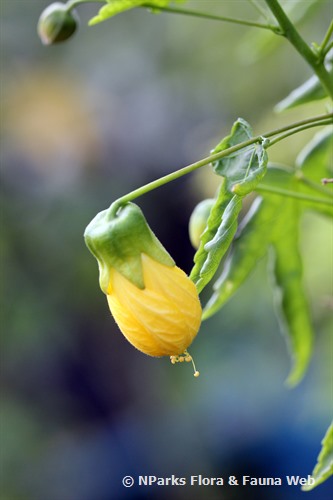
Back
Abutilon 'Canary Bird'
| Family Name: | Malvaceae |
Abutilon 'Canary Bird' is an evergreen shrub with attractive yellow cup-shaped flowers with numerous stamens, hanging downwards like bells. This perennial plant flowers freely throughout the year and has dark green palm-shaped leaves resembling maple.
Name
Classifications and Characteristics
| Plant Division | Angiosperms (Flowering Seed Plants) |
|---|---|
| Plant Growth Form | Shrub |
| Lifespan (in Singapore) | Perennial |
| Mode of Nutrition | Autotrophic |
| Plant Shape | Shrubby |
| Maximum Height | 3 m |
| Maximum Plant Spread / Crown Width | 3 m |
Biogeography
| Native Habitat | Terrestrial |
|---|---|
| Preferred Climate Zone | Tropical, Sub-Tropical / Monsoonal, Temperate |
| Local Conservation Status | Non-native (Horticultural / Cultivated Only) |
Description and Ethnobotany
| Growth Form | An evergreen woody shrub that can grow up to 3 m in height. |
|---|---|
| Foliage | Dark green, palmately-lobed leaves. |
| Stems | Woody stems |
| Flowers | Bell-shaped yellow flowers facing downwards, with numerous stamens. |
| Cultivation | Grows best under full sun to produce flowers. Requires little trimming to ensure plant shape. Apply balanced fertilizer monthly. Plant takes approximately 5 - 10 years to reach its optimum height. Can be propagated via softwood cuttings. |
| Etymology | Genus Abutilon is the Arabic name for mallow. |
Landscaping Features
| Landscaping | Suitable for container planting and borders for its pendant bright yellow bell-shaped flowers. |
|---|---|
| Desirable Plant Features | Ornamental Flowers, Ornamental Foliage |
| Landscape Uses | Parks & Gardens, Small Gardens, Container Planting |
| Thematic Landscaping | Bird & Wildlife Garden |
Fauna, Pollination and Dispersal
| Fauna Pollination Dispersal Associated Fauna | Bird-Attracting |
|---|
Plant Care and Propagation
| Light Preference | Full Sun |
|---|---|
| Water Preference | Moderate Water |
| Plant Growth Rate | Moderate |
| Rootzone Tolerance | Moist Soils, Well-Drained Soils, Fertile Loamy Soils |
| Transplanting Tolerance | Moderate |
| Maintenance Requirements | Low |
| Pruning | Can be pruned periodically to control its size and make the plant bushier. |
| Fertilizing | Apply once monthly with a balanced fertilizer. |
| Pest(s) | Sucking Insects |
| Propagation Method | Stem Cutting |
| Propagation Method Remarks | Softwood cuttings |
| Planting Distance | 3 m |
Foliar
| Foliage Retention | Evergreen |
|---|---|
| Mature Foliage Colour(s) | Green |
| Mature Foliage Texture(s) | Thin, Crinkled / Twisted |
| Prominent Young Flush Colour(s) | Green - Light Green |
| Young Flush Texture(s) | Smooth |
| Foliar Type | Simple / Unifoliate |
| Foliar Arrangement Along Stem | Alternate, Spiral |
| Foliar Attachment to Stem | Petiolate |
| Foliar Shape(s) | Non-Palm Foliage (Palmate) |
| Foliar Venation | Palmate |
| Foliar Margin | Palmately Lobed |
| Foliar Apex - Tip | Acute |
| Foliar Base | Cordate |
Non - Foliar and Storage
| Stem Type & Modification | Woody |
|---|---|
| Root Type | Underground (Tap Root) |
Floral (Angiosperm)
| Flower & Plant Sexuality | Bisexual Flowers |
| Flower Colour(s) | Yellow / Golden |
|---|---|
| Flower Texture(s) | Smooth |
| Flower Grouping | Solitary |
| Flower Location | Axillary |
| Flower Symmetry | Radial |
| Individual Flower Shape | Campaulate / Bell-shaped |
| Flowering Period | Free-Flowering |
| Flowering Habit | Polycarpic |
| Flower Size | 6 cm x 5 cm |
Image Repository
Others
| Master ID | 33726 |
|---|---|
| Species ID | 8140 |
| Flora Disclaimer | The information in this website has been compiled from reliable sources, such as reference works on medicinal plants. It is not a substitute for medical advice or treatment and NParks does not purport to provide any medical advice. Readers should always consult his/her physician before using or consuming a plant for medicinal purposes. |








